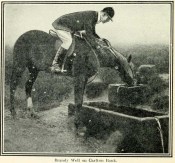Legendary Rock: OS Grid Reference – NF 092 996
Archaeology & History
This is a most intriguing site, whose exact location seems to have been forgotten. It was first mentioned in Macaulay’s History of St Kilda (1764) as being one of four stone altars that the islanders used for worship. Three of them were related to the early christian figure of St. Brendan, whose well and chapel remains are on the south-side of the island. However, this fourth stone altar possessed a purely magickal and heathen function. Macaulay initially gives the location as being “on top of a hill to the southwest” of St. Brendan’s chapel; but subsequently tells us it was upon “Mulach-geall” which is a mile NNW. It was an important place to the people of Hirta and its exact position needs to be found and, hopefully, the altar still exists.
Folklore
Despite Macaulay’s conflicting directions of how to get here (a common feature of early writers), he wrote:
“I have already made mention of one St. Kilda altar, that in Brendans Chapel. There are no less than four more in the island, of which three lie at considerable distances from the holy places. There is one particularly on the top of a hill to the south-weft (sic), dedicated according to tradition to the God who presides over Seasons; The God of thunder, lightning, tempests and fair weather. To avert the terrible judgments inflicted by this mighty Divinity, the ancient St. Kildians offered propitiatory sacrifices on this altar, sacrifices of different forts, much like the old Pagans, who offered a black sheep to Winter, or the Tempest, and a white one to the Spring… The place where the people of this island, offered their victims to Taranis, is called Mulach-geall, that is to say, the White eminence or hill…”
More than a hundred years later, Seton (1878) made mention of it, but added no further details.
The invocation to Nature’s elements is something we find echoed at some sites further east, such as the Well of the North Wind on Iona and its compatriot Well of the South Wind. At both these places, so-called ‘pagan’ rituals were used to both placate and invoke the gods and spirits of the wind. This one on St Kilda possessed additional magickal prowess. But where is it? Have we lost it, or is it sleeping somewhere on the edge of Mullach-Geal…?
References:
- Macaulay, Kenneth, The History of St. Kilda; Containing a Description of This Remarkable Island; the Manners and Customs of the Inhabitants; the Religious and Pagan Antiquities There Found, T. Becket: London 1764.
- Seton, Gordon, St. Kilda – Past and Present, William Blackwood: Edinburgh 1878.
© Paul Bennett, The Northern Antiquarian
